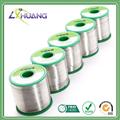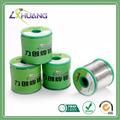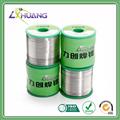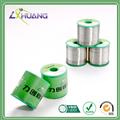Lead Free Solder

- High Temperature Alloy Solder the soldered joint should meets demands for thermal treatment after welding. As professional tin-based alloy manufacturer, we provide various solder bars/wires made from Sn-Sb alloy , Sn-Cu alloy , Sn-Cu-Ag alloy and Sn-Ag alloy .

- Medium High Temperature Alloy Solder Solder is a general term applied to fill the weld seam welding and brazing layers of metal alloy materials. Including welding (welding wire), welding (welding rod), solder (brazing and soldering alloy) and so on. The main requirements for the connection , but the strength of the small joints, such as electronic equipment, instruments , household appliances electronic circuit connector.

- Medium temperature Solder Alloy Medium temp lead-free solder refers to filler metals which are of medium melting points. It belongs to soft solder alloy which is opposed to the high-melting-point hard solder alloy. This solder is perfect for manual soldering, component installation as well as solder-joint repairing.

- Low Mid temperature Alloy Solder Lead-free solders generally available manufacturing method of the casting, i.e., said heavy metal raw materials, and heated and stirred in air melt in a crucible or pot. Solder alloy prepared by the method of the invention, its advantages First, reduce the melting point of the solder alloy, generally less than 200 ℃; Second, the solid-liquid phase difference between the alloy up the following 2 ℃, avoid isolated spot defects; Third alloy homogeneous, the alloy strength increases; Fourth spreading rate of the solder alloy can

- Low Temperature Alloy Solder Gold-tin solder alloys have high strength, good oxidation resistance, excellent resistance to thermal fatigue and creep resistance, low melting point, good fluidity characteristics, making it the best solder optoelectronic package. With the rapid development of optoelectronic devices, the demand for gold-tin solder alloy is also growing. Gold-tin solder alloy with excellent performance, high reliability, no pollution, has gradually been more and more people understand and apply.
Introduction
Containing very little plumbum (≤ 100 ppm),
the lead free solder meets increasing demands for environmental protection
around the world and gradually replaces the traditional tin-lead solders. Generally,
Pb free solders are widely used for soldering electronic components, computer
parts, copper plates, PCBs, TV parts, radio components and other metal
equipments. We offer multiple kinds of soldering alloys, including Sn-Cu,
Sn-Ag-Cu, Sn-Ag, Sn-Bi, and so on.
Advantages
1. Lead free solder is featured by good
welding performance, short wetting time, outstanding anti-oxidizability and
high tensile strength.
2. During welding, little nocuous volatile
gas and flux residue generate; besides, very little soldering splatters around.
3. Solder spot is bright and reliable for
welding.
4. Resin in the Pb free solders is uniformly
distributed and featured with good continuity.
5. Our lead free solder possesses small
surface tension and large flow ability.
How
to Choose Solder
1. Choose the Solder Composition Lead or Lead-free is the first thing to be
considered. Then, choose the right solder according to the working temperature.
Generally, solders used at high temperature are available for easily accessible
connections, while the ones at low temperature are for smaller and crowded
connections. Next thing is to choose right solder alloy. Commonly, the most
common lead free solder contains 95% tin and 5% antimony. Its smelting point is
between that of 40/60 and 50/50 tin/lead solders.
2. Select Right Diameter of Pb Free Solders Select solder wires whose diameter is
between 0.01 inch (0.25 mm) and
0.125 inch (3.25 mm). If
the solder diameter is too small, the solder will be melted very fast, and vice
versa. So, over-thin solder will result in lack of soldering, while the
over-think solder will absorb too much heat and damage the welded components.
3. Select Flux Core for Lead Free Solder Choose the flux cores
according to your personal style in applying flux.







